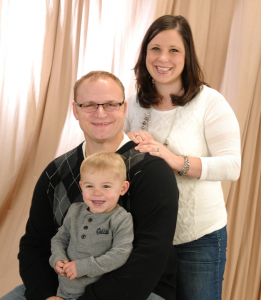Doctors’ Notes
BackCongenital Heart Defects
A special, and personal, note for Congenital Heart Defect Awareness Week…
One in every hundred… The country’s most common birth defect… The leading cause of all infant death in the United States. These were all statistics about congenital heart defects that I’d heard and learned during my time in Physician Assistant school.

But they took on a whole new meaning on November 22, 2011.
That was the day that, during a routine 20-week ultrasound, my wife Tanya and I were introduced into the Congenital Heart Defect (CHD) community through something called Hypoplastic Left Heart Syndrome. That was the day we learned that if our baby survived to birth, he would essentially be born with half a heart. Among the various defects they found, he would ultimately be missing the vital left side of the heart that pumps oxygenated blood out to the rest of the body.
The month of February is generally associated with Valentine’s Day, love, and hearts. But February is more than chocolate hearts. It’s also Heart Awareness month — a time for us to celebrate mended hearts, remember hearts that have earned their angel wings, and raise awareness and funding for this horrible disease that has no cure. Many heart organizations spend the month educating people about congenital and acquired heart disease and stroke. The week of February 7th – February 14th is dedicated as Congenital Heart Defect Awareness Week.
Like us on that November day, many people are unaware that congenital heart defects are the most common birth defect in the United States, and that they affect approximately 40,000 new children each year. Thousands of these children will die before their first birthday, and thousands more will never reach adulthood. In the United States, more children die from congenital heart defects yearly than all forms of pediatric cancers combined, yet funding for CHD is 5 times lower than that of pediatric cancer. There is no cure for CHD. However, through research, new techniques and information about the diseases that affect these tiny hearts are on the rise.
Our son, Cael, fought his way into the world, and through these first 10 months of his life. He’s undergone 5 procedures and is doing great now. In our opinion, we were fortunate that we found out about Cael’s defects prior to his birth. Many families don’t find out about their baby’s heart defect until after birth, when something “doesn’t seem right,” or when a larger problem arises.
The earlier a CHD is detected, the better. Early detection allows for the proper testing and management to be initiated and helps keep the baby safe.
There are 3 important things that parents can do to help monitor for congenital heart defects:
1. At the mid-pregnancy anatomy ultrasound, there are 5 questions about the heart you should ask:
- Is the heart rate normal?
- Do you look at the arteries as part of your ultrasound?
- Are the heart and stomach in the correct location and position?
- Do you see 4 chambers in the heart?
- Is the function of the heart normal?
2. After the child is born, the acronym CORBIN can be used to detect a possible cardiac abnormality. If you notice any of these signs, be sure to discuss it with your doctor right away:
Color – bluish skin or extremities
Oxygen – low pulse ox percentage
Rhythm – abnormal heart rate
Breathing – heavy or labored
Increase in sweat, especially during feedings
Nursing – nursing issues, especially breathing and feeding at the same time
3. Ask for a PulseOx test. This is as simple as putting a sticker on the baby’s foot or hand. This test shows how much oxygen is in the baby’s blood and alerts the physician if there is a problem with the heart. As a standard protocol, many hospitals in Pittsburgh are now screening all newborns in the nursery with the PulseOx test. Don’t be afraid to ask in the hospital about the results of the test.
Please share these three simple procedures with any friends or family who are expecting, and join with us as we raise awareness about congenital heart defects and celebrate hearts that have stitches, wires, and a fix — but still no cure!
Happy Heart Month!
Travis Lewis, a Kids Plus Provider, is a certified Athletic Trainer and a certified Physician Assistant.